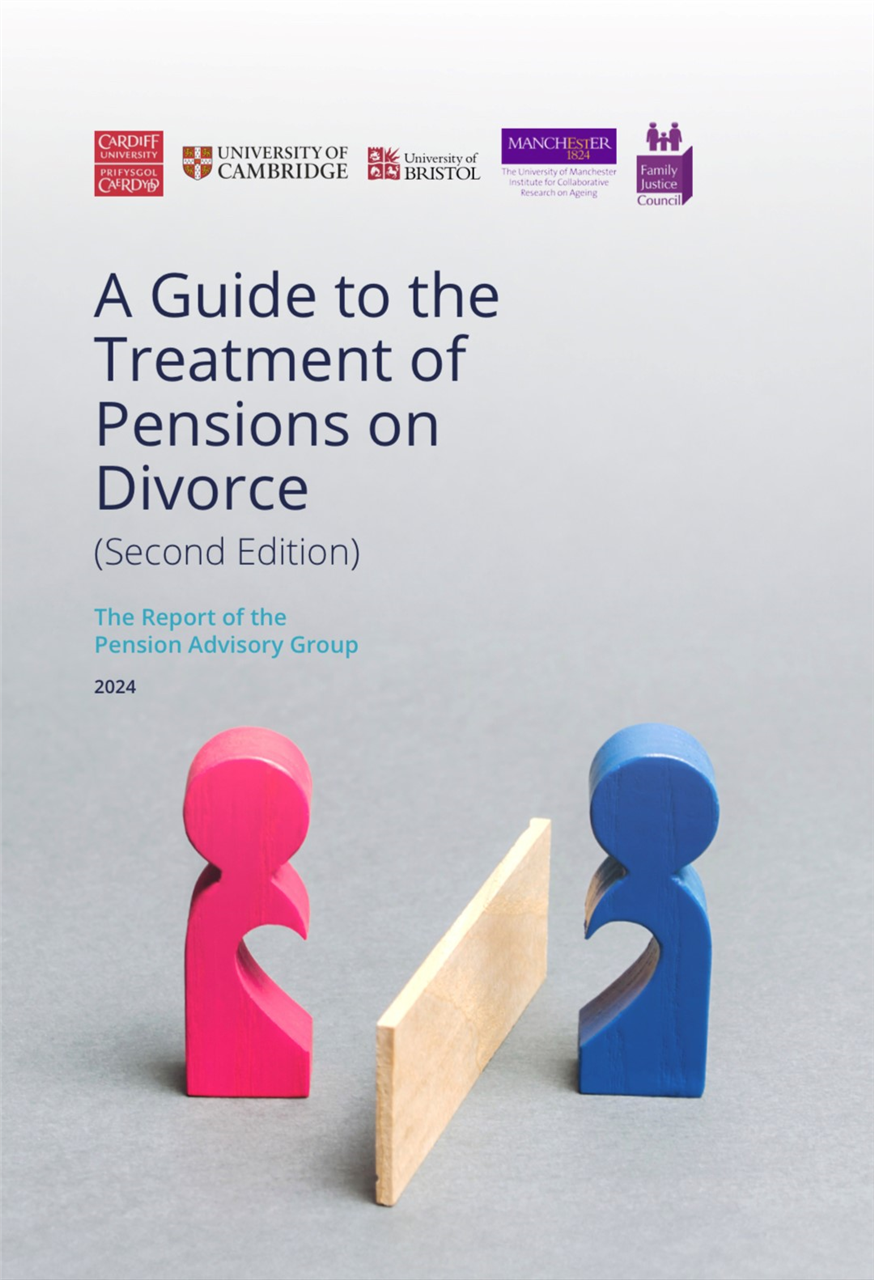
The PAG2 Guide – What Has Changed?
Published: 22/01/2024 11:43

The publication of the Pension Advisory Group (PAG2) guidance in December 2023 marked the end of another lengthy and significant piece of interdisciplinary work by experienced practitioners in the field of pensions on divorce.
Much has already been written about the new guide and the overall changes, so the aim of this piece is to focus just on the material changes in what is now referred to as the PAG2 guide.
It is worth highlighting that the remit of the two PAG2 working groups was not to re-write the original guidance or to start afresh. Rather, the instruction was to make changes only where they were required, where case-law had moved on since 2019, to correct any errors and omissions and to make any improvements in light of feedback PAG has received since 2019.
The main changes can be summarised as follows:
General
There has been a general refresh of the original text, including changes to legal terminology following the introduction of no-fault divorce, and the addition of references to recent case law.
References have also been added to direct readers to relevant blogs and articles in the Financial Remedies Journal, as well as articles in Family Law.
Part 4 – Treatment of pensions in ‘needs-based’ and ‘sharing’ (non-needs) cases
Significant guidance update to entire section, including:
4.4 – Whilst there can be no ‘one size fits all’ approach to the interplay between ‘needs’ and ‘sharing’, it would be wrong to apportion pensions so as to exclude the ‘non-cohabitation/marriage’ element without first considering the relevant s.25 factors, which in most cases [save where parties young or marriage is very short] will include the income needs of the parties in retirement
4.6 – If apportionment is justified, then the date for commencement of apportionment will almost without exception be the date of commencement of seamless cohabitation, and not the date of marriage, see for example GW v RW [2003] EWHC 611 (Fam), Co v Co (Ancillary Relief – Pre Marriage Cohabitation) [2004] 1 FLR 1095.
4.7 – Post separation accrual – there remains room for debate and some conflict in the authorities, with references to the various key competing cases.
4.8 to 4.11 – Section on Short Marriages now added.
Part 6 – Dealing with pensions fairly on divorce
6.4 – Reference to Defined Benefit tax free cash differences and pension credits from already crystallised benefits, known as ‘disqualifying pension credit’
6.4 – Percentage pension share must apply to each component of a pension arrangement, including crystallised and uncrystallized benefits
6.10 Case 1 – Commentary on the Defined Contribution issues to be aware of.
6.10 Case 3 – ‘Big Money’ cases where pensions are relatively modest in value compared to the capital – the approach in the High Court exemplified by SJ v RA [2014] EWHC 4054 and CMX v EJX (French Marriage Contract) [2022] EWFC 136
6.11 Case 5 – Comment added – There may be terms on your firm’s professional indemnity insurance that requires a PODE report to be recommended to be obtained for all pension funds over the value of £100,000, whatever the nature.
6.11 Case 12 – Cases in Family Court below High Court level exemplified by W v H (divorce financial remedies) [2020] EWFC B10
6.15 to 6.29 – greatly expanded commentary regarding the debate and leading authorities/ opinions for equality of income v equality of capital
Part 7 – Pension Offsetting
Expansion of Key Points to highlight issue relating to the weight to be attached to PODE offsetting figures.
7.24 – Inclusion of the Galbraith tables as an offsetting valuation methodology and commentary on and the limitations of these tables [7.25]
7.31 – Expansion of guidance on adjusting for tax in offsetting cases.
7.34 – Some PODEs may consider that when the offset amount is invested it may be subject to tax.
Part 8 – Pension Freedoms
8.21 – Commentary on changes to the Normal Minimum Pension Age from 2028
Part 9 – Taxation of pension benefits
Refresh of all pension tax allowances
9.6 – Commentary on the abolition of the LTA
9.7 – Explanation of anticipated restrictions to future tax-free cash amounts, the legacy of LTA protections continuing and the introduction of a new Lump Sum Allowance and a Lump Sum Death Benefit Allowance
9.8 – Funding changes for those with Fixed Protections
Part 10 – Age differential and ‘income gap’ syndrome
Expansion of Key Points
10.8 – Possible mitigation of the ‘age differential and income gap syndrome’ issue – expanded from 6 to 10 ways, new methods including Judicial Separation, Spousal Maintenance, an increased percentage PSO and Consecutive Orders (PAO to PSO)
Part 11 – State Pensions
Expansion of Key points
11.3 New commentary on reclaiming credits from ex-spouses where ‘working spouse’ also claimed child benefit and effectively obtained duplicate credits
11.20 – New guidance if considering apportioning State Pension rights to period of cohabitation/marriage
Part 12– Some issues in valuing pensions for divorce
12.2 – Additional commentary that pre-marital cohabitation running seamlessly into marriage should be treated as part of the marriage
Part 13 – Pensions where an application has been made to vary the original order
Significant expansion of Part 13 by inclusion of new sections on Applications to vary Pension Sharing Orders [13.10 to 13.17] and Applications to set aside Pension Sharing Orders [13.18 to 13.25], including detailed case law commentary and references
Part 14 – Pensions and International issues
14.11 – Refinement to post Brexit changes
Appendix A – Glossary
General refresh and some additions
Appendix C – Who can be instructed as a PODE or SJE
General refresh and update
C.8 – Suggests that when instructing experts, check to ensure the PODE currently resides in the UK and expects to do so for the foreseeable future
Appendix D – Self-certification of expertise
General refresh
xxii – New para 22 dealing with experts having appropriate arrangements in place to cover professional shortcomings
Appendix E – Specimen letter of instruction to SJE/PODE
Some amendments to letter of instruction and the notes now recorded separately to the letter for ease of reference
Appendix F – Post-order implementation issues
New Key Points commenting on new Standard Family Order template and unresolved debate about when the 28 days starts where a Rose Order is made at FDR.
F.31 – New paragraph referencing Goodyear v Goodyear (Deceased) [2022] EWFC 96
Appendix I – Complexities in certain public sector occupational schemes
I.6 – Updated commentary regarding the McCloud ruling
I.41 to I.54 – Significant new material on the McCloud ruling and the McCloud remedy
Appendix J – Underfunding of Defined Benefit schemes and reduced CEs
J.6 – Reference to danger of ticking box F in the PSO and reference to T v T (Variation of a Pension Sharing Order and underfunded schemes) [2021] EWFC B67
Appendix K – The Pension Protection Fund and Financial Assistance Scheme
Significant refresh of chapter, particular regarding the Financial Assistance Scheme, with assistance from the PPF
Appendix S – Apportionment of final salary pension rights
Additional commentary on specific issues with each method of apportionment
S.8 – New commentary about extra work involved in ‘Deferred Pension’ method
S.12 – New commentary about flaws of CE method
S.13, S.14 and S.15 – Additional commentary on ‘Straight-line’ method
S.16 – New commentary on PAG’s preferred approaches
Appendix U – A future approach to pension valuation. The emergence of the Galbraith Tables
Valuing pensions – The emergence of the Galbraith tables as a new development replaces the previous Appendix U suggesting ideas for the development of such tables
Appendix V – Recommendations for issues beyond the remit of PAG
V.30 – Recommendations for changes to Form A
V.31 and V.32 – Recommendations for changes to Form P and a suggestion for a modernising review by the Family Procedure Rule Committee









